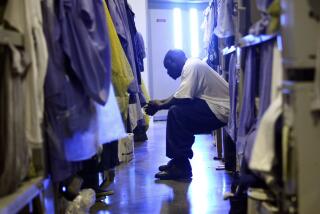PERSPECTIVE ON JUSTICE : Crime, Maybe A Little Punishment : The median sentence for murder in state prisons around the United States is 5 1/2 years; for rape,it is three years.
- Share via
We send too many people to prison for too long and at too great a cost. It is a familiar refrain. We hear it from advocacy groups, columnists, academics and legal organizations.
The purpose is clear: to mold public sentiment against punishment and incarceration. Yet a growing body of data, most of it published by the Bureau of Justice Statistics of the U.S. Department of Justice, tells quite a different story. These data demonstrate the striking contrast between this myth of American punitiveness and the reality of crime and justice in the United States.
First, very few persons arrested for felonies in the United States end up sentenced to state prisons.
Felonies are the most serious criminal offenses and include such crimes as murder, rape, robbery, aggravated assault, burglary, arson, drug trafficking and weapons offenses.
Most recent data show that the odds that a person arrested for a felony will eventually be sentenced to state prison for a year or more are about 1 in 10, and for violent felonies about 1 in 8. (Another 4 in 10 will be sentenced to a local jail for less than a year--many for just a few days or weeks).
Second, many convicted felons are not incarcerated at all.
Data from a 1988 national survey show that state courts throughout the nation convicted 667,000 persons of felonies that year. (Federal courts convicted another 31,000 of felonies.) State courts sentenced 44% of the convicted felons to state prison, 25% to local jail (again, usually for less than a year) and 31% to probation or some other non-incarceration sentence.
This means that more than 200,000 convicted felons received no prison or jail time. Of these, 69,000 were convicted of rape, aggravated assault, drug trafficking or burglary.
Third, our state prisons are filled with convicted violent offenders and convicted recidivists.
According to a comprehensive 1991 federal survey, about three-fifths of state prison inmates had a record of at least one violent crime conviction. One in five of all prisoners was serving time for murder or sexual assault.
For all state prison inmates, 79% were serving at least their second sentence to prison or probation; 60% their third; 45% their fourth, and 18% at least their seventh. Altogether, 93% of state prison inmates were either convicted violent offenders or convicted recidivists.
Fourth, state prisoners currently serve very short sentences.
Over and over we are told that we keep criminals in prison “too long” but never how long. And the reason is clear: Those who promulgate the punitiveness myth do not want us to know just how little time criminals actually spend behind bars in the United States.
For example, of the several hundred thousand inmates released from state prisons in 1988, half served a year and a month in prison or less. For drug traffickers, the median time served was one year; for burglars, 13 months; for arsonists, 17 months; for rapists, three years, and for murderers, 5 1/2 years.
Finally, the great majority of those under correctional supervision are serving their sentences in the community, not behind bars.
Data from the end of 1990 show that of the 4.4 million offenders then serving criminal sentences in the United States, fully 74%--more than 3 million--were serving their time in the community (on probation or parole), while the balance were in prisons or jails. Is this kind of ratio--three convicted criminals on probation or parole for every one in prison or jail--the mark of a society obsessed with locking up criminals and throwing away the key?
Those who argue that we punish criminals too severely have been less than forthcoming about the consequences of their schemes to lessen punishment for criminal offenses.
They should say straight out that they want to see even more than 200,000 convicted felons released by courts to our communities each year without time behind bars--perhaps 300,000 or 400,000?--and that they want murderers to serve less than 5 1/2 years in prison, rapists less than three years, burglars less than 13 months and drug traffickers less than a year.
Does anyone really believe that these kinds of changes would serve justice, increase citizen confidence in the nation’s governing institutions or make for a safer society?
More to Read
Sign up for Essential California
The most important California stories and recommendations in your inbox every morning.
You may occasionally receive promotional content from the Los Angeles Times.










